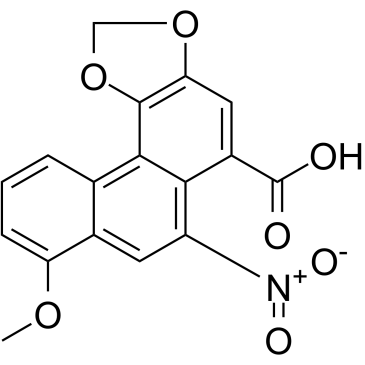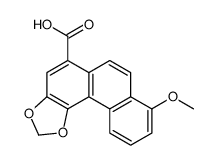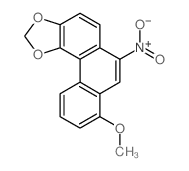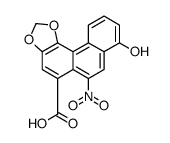313-67-7
| Name | aristolochic acid |
|---|---|
| Synonyms |
Aristolohic Acid A
Descresept 8-methoxy-3,4-methylenedioxy-10-nitrophenanthrene-1-carboxylic acid Aristolochic acid birthwort AristolochicacidI EINECS 206-238-3 Aristolochia tardolyt Aristolochic Acid A Aristolochia A aristolochin 8-Methoxy-6-nitrophenanthro[3,4-d][1,3]dioxole-5-carboxylic acid TR 1736 Aristolochic MFCD00004996 aristolochine 8-Methoxy-6-nitrophenanthro[3,4-d]-1,3-dioxole-5-carboxylic Acid |
| Description | Aristolochic acid A (Aristolochic acid I) is the main component of plant extract Aristolochic acids, which are found in various herbal plants of genus Aristolochia and Asarum. AAI significantly reduces both activator protein 1 (AP-1) and NF-κB activities. Aristolochic acid A reduces BLCAP gene expression in human cell lines[1]. |
|---|---|
| Related Catalog | |
| In Vitro | Aristolochic acid A (150, 200 μM, 24 hours) inhibits the cell viabilities of kidney cells HEK293 and HK-2[1]. Aristolochic acid A (100, 200 μM, 24 hours) causes a concentration-dependent decrease in bladder cancer-associated protein (BLCAP) mRNA levels in kidney cells (HEK 293 and HK-2) , and bladder cancer cell line (HT-1376)[1]. Aristolochic acid A (100, 200 μM, 24 hours) weakens the BLCAP protein signals in a dose-dependent manner in both HEK293 and HT-1376 cells[1]. Cell Viability Assay[1] Cell Line: Kidney cells (HEK 293 and HK-2) Concentration: 50, 100, 150, 200 μM Incubation Time: 24 hours Result: The cell viabilities of HEK293 and HK-2 were lower than that of vehicle-treated cultures until 150 μM and 200 μM. RT-PCR[1] Cell Line: Kidney cells (HEK 293 and HK-2), and bladder cancer cell line (HT-1376) Concentration: 100, 200 μM Incubation Time: 24 hours Result: Down regulated the levels of BLCAP mRNA. Western Blot Analysis[1] Cell Line: HEK293 and HT-1376 cells Concentration: 100, 200 μM Incubation Time: 24 hours Result: Reduced the BLCAP protein expression in a dose-dependent manner. |
| References |
| Density | 1.6±0.1 g/cm3 |
|---|---|
| Boiling Point | 615.5±55.0 °C at 760 mmHg |
| Melting Point | 260 °C |
| Molecular Formula | C17H11NO7 |
| Molecular Weight | 341.27 |
| Flash Point | 326.0±31.5 °C |
| Exact Mass | 341.053558 |
| PSA | 110.81000 |
| LogP | 3.41 |
| Vapour Pressure | 0.0±1.9 mmHg at 25°C |
| Index of Refraction | 1.747 |
| Water Solubility | DMSO: soluble |
CHEMICAL IDENTIFICATION
HEALTH HAZARD DATAACUTE TOXICITY DATA
MUTATION DATA
|
| Symbol |

GHS06 |
|---|---|
| Signal Word | Danger |
| Hazard Statements | H301 |
| Precautionary Statements | P301 + P310 |
| Personal Protective Equipment | Eyeshields;Faceshields;Gloves;type P2 (EN 143) respirator cartridges |
| Hazard Codes | T:Toxic |
| Risk Phrases | R25 |
| Safety Phrases | S7-S35-S45 |
| RIDADR | UN 1544 6.1/PG 3 |
| WGK Germany | 3 |
| RTECS | CF3325000 |
| Packaging Group | III |
| Hazard Class | 6.1(b) |
| Precursor 0 | |
|---|---|
| DownStream 6 | |




![Phenanthro[4,3-d]-1,3-dioxole-5-carboxylicacid, 8-methoxy-6-nitro-, methyl ester structure](https://image.chemsrc.com/caspic/087/1169-60-4.png)

